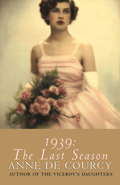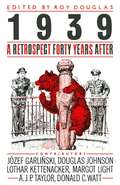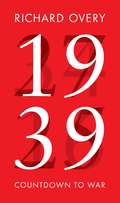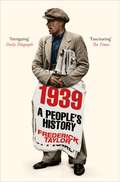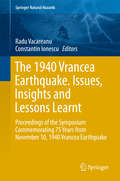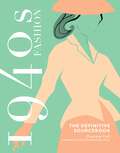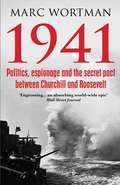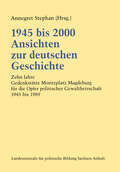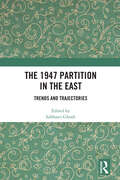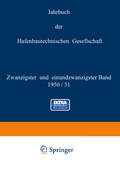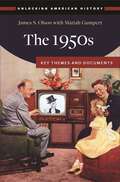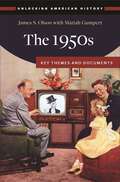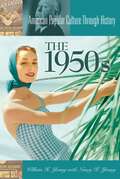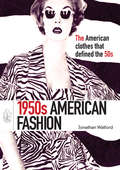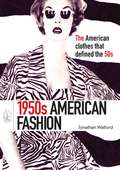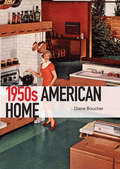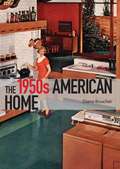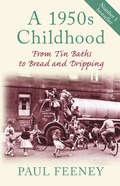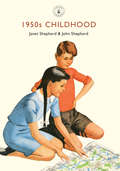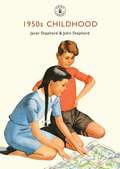- Table View
- List View
1939: The Last Season
by Anne de CourcyA wonderful portrait of British upper-class life in the Season of 1939 - the last before the Second World War.The Season of 1939 brought all those 'in Society' to London. The young debutante daughters of the upper classes were presented to the King and Queen to mark their acceptance into the new adult world of their parents. They sparkled their way through a succession of balls and parties and sporting events.The Season brought together influential people not only from Society but also from Government at the various events of the social calendar. Prime Minister Neville Chamberlain chaperoned his debutante niece to weekend house parties; Lord Halifax, the Foreign Secretary, lunched with the Headmaster of Eton; Cabinet Ministers encountered foreign Ambassadors at balls in the houses of the great hostesses. As the hot summer drew on, the newspapers filled with ever more ominous reports of the relentless progress towards war. There was nothing to do but wait - and dance. The last season of peace was nearly over.
1939: A Retrospect Forty Years After (PDF)
by Roy Douglas1939 a retrospect forty years after : proceedings of a conference held at the University of Surrey 27 October 1979
1939: Countdown to War
by Richard Overy24 August 1939: The fate of the world is hanging in the balance. Hitler has ambitions to invade Poland and hopes Stalin will now help him. And the West must try to stop him. If they don't, world war will result.In this dramatic account of the last days of peace in 1939, Richard Overy re-creates hour by hour the unfolding story in the capitals of Europe as politicians and the public braced themselves for a war that they feared might spell the end of European civilisation. There was nothing entirely predictable or inevitable about the outcome. The West hoped that Hitler would see sense if they stood firm. Hitler was convinced the West would back down. There were moments of hesitation and moments of confrontation; secret intelligence was used by both sides to support their hopes. The one constant feature was the determination of Poland, a country created only in 1919, to fight a war that seemed entirely irrational, against the armed might of Germany. Countdown to War brings to life a defining moment in the history of the violent twentieth century.
1939: A People's History
by Frederick Taylor‘In 1939: A People's History, Frederick Taylor has done us a great service in making the personal stories of what it was actually like to live through the most crucial year of the twentieth century vivid, compelling and salutary.’ - Roland Philipps, author of A Spy Named Orphan: The Enigma of Donald MacleanIn the autumn of 1938, Europe believed in the promise of peace. Still reeling from the ravages of the Great War, its people were desperate to rebuild their lives in a newly safe and stable era. But only a year later, the fateful decisions of just a few men had again led Europe to war, a war that would have a profound and lasting impact on millions of innocent people. From the bestselling historian Frederick Taylor, 1939: A People's History draws on original British and German sources, including recorded interviews, as well as contemporary diaries, memoirs and newspapers. Its narrative focuses on the day-to-day experiences of the men and women in both countries trapped in this disastrous chain of events and not, as is so often the case, the elite. Their voices, concerns and experiences lend a uniquely intimate flavour to this often surprising account, revealing a marked disconnect between government and people; few ordinary citizens in either Britain or Germany wanted war. Precisely for that reason, 1939: A People's History is also an interrogation of our capacity to go to war again. In today’s Europe, an onset of uncertainty, a looming fear of radical populism and a revelatory schism are dangerously reminiscent of the perils of the autumn of 1938. It is both a vivid and richly peopled narrative of Europe’s slide into the horrors of war, a war that nobody wanted, and, in many ways, a warning; an opportunity for us to learn from our history and a reminder that we must never take peace for granted.
The 1940 Vrancea Earthquake. Issues, Insights and Lessons Learnt: Proceedings of the Symposium Commemorating 75 Years from November 10, 1940 Vrancea Earthquake (Springer Natural Hazards)
by Radu Vacareanu Constantin IonescuThese proceedings include most of the available information on this major seismic event and its consequences. With an estimated moment magnitude of 7.7 and a heavy toll in terms of human and economic losses, it ranks as the largest intermediate-depth earthquake in Europe in the twentieth century. Nevertheless, because of the difficult conditions in the 1940s, the lessons learnt after the Vrancea earthquake were not extensively shared with the international scientific community and thus, this book fills a gap in the literature discussing the knowledge acquired after major disasters. Past experience together with current understanding of the 1940 Vrancea earthquake are presented along with the latest information on Romanian seismicity, seismic hazard and risk assessment, and seismic evaluation and rehabilitation of buildings and structures. Moreover, it includes excerpts from Romanian post-disaster reports and textbooks concerning the earthquake.
A 1940s Childhood: From Bomb Sites to Children's Hour (Childhood Ser.)
by James MarshDo you remember collecting shrapnel and listening to Children’s Hour? Carrying gas masks or sharing your school with evacuees from the city? The 1940s was a time of great challenge for everyone who lived through it. From the hardships and fear of a World War, with Britain’s towns and cities were being bombed on an almost nightly basis, to the trauma of being parted from ones parents and sent away to the country to live with complete strangers. For just over half of this decade the war continued, meaning food and clothing shortages became a way of life. But through it all, and afterwards, the simplicity of kids shone through. From collecting bits of shot down German aircraft to playing in bomb-strewn streets, kids made their own fun. Then there was the joy of the second half of this decade when fathers came home and fun things started up again. This trip down memory lane will take you through the most memorable and evocative experiences of growing up in the 1940s.
1940s Fashion: The Definitive Sourcebook
by Charlotte FiellFrom the ashes of the Second World War came forward-thinking fashions, the likes of which had never been seen before. The early Forties were defined by thriftiness and practicality, a make-do-and-mend attitude in a time of war. However, the latter half of the decade saw the emergence of the traditional femininity, elegance and luxury often associated with the era. Spanning the austerity of the war years to the introduction of Dior's revolutionary New Look, this extensive survey brings together vintage photography and illustrations to follow the season-by-season fashion evolution of the Forties, providing a comprehensive overview of this period of contrasts.1940s Fashion: The Definitive Sourcebook covers every aspect of female fashions from the decade, from lace evening gowns, tailored jackets and furs to figure-sculpting undergarments, satin negligées and scandalous bikinis, offering the most comprehensive appraisal of this age of wartime and post-war glamour. This in-depth look at the styles and trends that shaped 1940s fashion features images of the decade's most iconic stars and designers. Stylish leading ladies such as Veronica Lake, Joan Bennett and Barbara Stanwyck are included as well as designs by Dior, Lucien Lelong, Balmain and Worth.Authored and edited by renowned design historian, Charlotte Fiell, this volume also contains an authoritative introduction by fashion historian, Emmanuelle Dirix, as well as the biographies of the key designers and fashion houses of the period.
1941: Fighting the Shadow War: How Britain and America Came Together for Victory
by Marc WortmanIn 1941: Fighting the Shadow War, Marc Wortman thrillingly explores the little-known history of America's clandestine involvement in World War II before the attack on Pearl Harbor. Prior to that infamous day, America had long been involved in a shadow war. Winston Churchill, England's beleaguered new Prime Minister, pleaded with Franklin D. Roosevelt for help. President Roosevelt concocted ingenious ways to come to his aid, without breaking the Neutrality Acts. Conducting espionage at home and in South America to root out Nazi sympathizers, and waging undeclared war in the Atlantic, were just some of the tactics with which America battled Hitler in the shadows. President Roosevelt also had to contend with growing isolationism and anti-Semitism as he tried to influence public opinion. While Americans were sympathetic to those being crushed under Axis power, they were unwilling to enter a foreign war. Wortman tells the story through the eyes of the powerful as well as ordinary citizens. Their stories weave throughout the intricate tapestry of events that unfold during the crucial year of 1941. Combining military and political history, Wortman tells the eye-opening story of America's journey to war.
1942: Britain at the Brink
by Taylor Downing'Taylor Downing vividly brings to life a terrible year' Max Hastings Sunday TimesEighty years ago, Britain stood at the brink of defeat. In 1942, a string of military disasters engulfed Britain in rapid succession : the collapse in Malaya; the biggest surrender in British history at Singapore; the passing of three large German warships through the Straits of Dover in broad daylight; the longest ever retreat through Burma to the gates of India; serious losses to Rommel's forces in North Africa; the siege of Malta and the surrender at Tobruk. All of this occurred against the backdrop of catastrophic sinkings in the Atlantic and the Arctic convoys. People began to claim that Churchill was not up to the job and his leadership was failing badly. Public morale reached a new low. 1942 Britain At the Brink explores the story of frustration and despair in that year prompting the Prime Minister to demand of his army chief 'Have you not got a single general who can win battles?' Using new archival material, historian Taylor Downing shows just how unpopular Churchill became in 1942 with two votes attacking his leadership in the Commons and the emergence of a serious political rival. Most people think that Britain's worst moment of the war was in 1940 when the nation stood up against the threat of German invasion. In 1942 Britain at the Brink, Taylor Downing describes in nail-biting detail what was really Britain's darkest hour .
1943: The Victory That Never Was
by John GriggOn June 6 1944 - 'D-Day' - Allied troops landed in France, opening a way to eventual victory. In this provocative reappraisal of the Second World War, John Grigg suggests that the Allied invasion could have been launched successfully in the previous year, reducing considerably the scale of the war's human tragedy. 'By 1943, Grigg notes, we already had air supremacy in the ETO and more than enough trained troops to launch a cross-Channel invasion; besides, with the Wehrmacht still deep in Russia, German supply lines would have been stretched to the breaking point. Had the Western Allies liberated only France and Belgium in 1943, speculates Grigg, they could have negotiated with Stalin from a position of strength.' Kirkus Review 'A forceful, argumentative, disputatious book, intended to make people think over old prejudices and discard them.' Economist
1945 bis 2000 Ansichten zur deutschen Geschichte: Zehn Jahre Gedenkstätte Moritzplatz Magdeburg für die Opfer politischer Gewaltherrschaft 1945 bis 1989
by Annegret StephanZwölf namhafte Autoren halten eine Rückschau auf zehn Jahre Vergangenheitsklärung der jüngeren deutschen Geschichte. Aus unterschiedlichen Forschungsansätzen und Blickwinkeln entsteht eine Zwischenbilanz der Aufarbeitung des SED-Systems.
1946: The Making Of The Modern World
by Victor SebestyenWith the end of the Second World War, a new world was born. The peace agreements that brought the conflict to an end implemented decisions that not only shaped the second half of the twentieth century, but continue to affect our world today and impact on its future. In 1946 the Cold War began, the state of Israel was conceived, the independence of India was all but confirmed and Chinese Communists gained a decisive upper hand in their fight for power. It was a pivotal year in modern history in which countries were reborn and created, national and ideological boundaries were redrawn and people across the globe began to rebuild their lives.In this remarkable history, the foreign correspondent and historian Victor Sebestyen draws on contemporary documents from around the world - including Stalin's personal notes from the Potsdam peace conference - to examine what lay behind the political decision-making. Sebestyen uses a vast array of archival material and personal testimonies to explore how the lives of generations of people across continents were shaped by the events of 1946. Taking readers from Berlin to London, from Paris to Moscow, from Washington to Jerusalem and from Delhi to Shanghai, this is a vivid and wide-ranging account of both powerbrokers and ordinary men and women from an acclaimed author.
The 1947 Partition in The East: Trends and Trajectories
by Subhasri GhoshThis book explores the experiences of people affected by the Partition of British India and princely states in 1947 through first-person accounts, memoirs, archival material, literature, and cinema. It focuses on the displacement, violence and trauma of the people affected and interrogates the interrelationships between nationalism, temporality, religion, and citizenship. The authors examine the mass migrations triggered by the 1947 Partition, amidst nationalist posturing, religious violence, and debates on crucial issues of refugee rehabilitation and redistribution of land and resources. It focuses on the drawing of the borders and the ruptures in the socio-cultural bonds within regions and communities brought on by demographic changes, violence, and displacement. The volume reflects on the significant mark left by the event on the socio-political sensibilities of various communities, and the questions of identity and citizenship. It also studies the effects of Partition on the politics of Bangladesh and India’s east and northeast states, specifically Bengal, Assam and Tripura. A significant addition to the existing corpus on Partition historiography, this book will be of interest to modern Indian history, partition studies, border studies, sociology, refugee and migration studies, cultural studies, literature, post-colonial studies and South Asian studies, particularly those concerned with Bengal, Northeast India and Bangladesh.
The 1947 Partition in The East: Trends and Trajectories
by Subhasri GhoshThis book explores the experiences of people affected by the Partition of British India and princely states in 1947 through first-person accounts, memoirs, archival material, literature, and cinema. It focuses on the displacement, violence and trauma of the people affected and interrogates the interrelationships between nationalism, temporality, religion, and citizenship. The authors examine the mass migrations triggered by the 1947 Partition, amidst nationalist posturing, religious violence, and debates on crucial issues of refugee rehabilitation and redistribution of land and resources. It focuses on the drawing of the borders and the ruptures in the socio-cultural bonds within regions and communities brought on by demographic changes, violence, and displacement. The volume reflects on the significant mark left by the event on the socio-political sensibilities of various communities, and the questions of identity and citizenship. It also studies the effects of Partition on the politics of Bangladesh and India’s east and northeast states, specifically Bengal, Assam and Tripura. A significant addition to the existing corpus on Partition historiography, this book will be of interest to modern Indian history, partition studies, border studies, sociology, refugee and migration studies, cultural studies, literature, post-colonial studies and South Asian studies, particularly those concerned with Bengal, Northeast India and Bangladesh.
The 1950s: Key Themes and Documents (Unlocking American History)
by James S. Olson Mariah GumpertThis volume serves as an invaluable guide to key political, social, and cultural concepts of the 1950s.This volume covers the entire decade of the 1950s, from the uneasy peace following World War II to the beginnings of cultural discontent that would explode in the 1960s. It highlights key historical, social, and cultural elements of the period, including the Cold War and perceived communist threat; the birth of the middle class and establishment of consumer culture; the emergence of the civil rights movement; and the normalization of youth rebellion and rock and roll. An introduction presents the historical themes of the period, and an alphabetical encyclopedic entries relating to period-specific themes comprises the core reference material in the book. The book also contains a range of primary documents with introductions and a sample Documents Based Essay Question. Other features are a list of "Top Tips" for answering Documents Based Essay Questions, a thematically tagged chronology, and a list of specific learning objectives readers can use to gauge their working knowledge and understanding of the period.
The 1950s: Key Themes and Documents (Unlocking American History)
by James S. Olson Mariah GumpertThis volume serves as an invaluable guide to key political, social, and cultural concepts of the 1950s.This volume covers the entire decade of the 1950s, from the uneasy peace following World War II to the beginnings of cultural discontent that would explode in the 1960s. It highlights key historical, social, and cultural elements of the period, including the Cold War and perceived communist threat; the birth of the middle class and establishment of consumer culture; the emergence of the civil rights movement; and the normalization of youth rebellion and rock and roll. An introduction presents the historical themes of the period, and an alphabetical encyclopedic entries relating to period-specific themes comprises the core reference material in the book. The book also contains a range of primary documents with introductions and a sample Documents Based Essay Question. Other features are a list of "Top Tips" for answering Documents Based Essay Questions, a thematically tagged chronology, and a list of specific learning objectives readers can use to gauge their working knowledge and understanding of the period.
The 1950s (American Popular Culture Through History)
by William H. YoungHave the 1950s been overly romanticized? Beneath the calm, conformist exterior, new ideas and attitudes were percolating. This was the decade of McCarthyism, Levittowns, and men in gray flannel suits, but the 1950s also saw bold architectural styles, the rise of paperback novels and the Beat writers, Cinema Scope and film noir, television variety shows, the Golden Age of the automobile, subliminal advertising, fast food, Frisbees, and silly putty. Meanwhile, teens attained a more prominent role in American culture with hot rods, rock 'n' roll, preppies and greasers, and—gasp—juvenile delinquency. At the same time, a new technological threat, the atom bomb, lurked beneath the surface of the postwar decade. This volume presents a nuanced look at a surprisingly complex time in American popular culture.
1950s American Fashion (Shire Library USA)
by Jonathan WalfordThe 1950s was the first decade when American fashion became truly American. The United States had always relied on Europe for its style leads, but during World War II, when necessity became the mother of invention, the country had to find its own way. American designers looked to what American women needed and found new inspirations for American fashion design. Sportswear became a strength, but not at the expense of elegance. Easy-wear materials were adapted for producing more formal clothes, and versatile separates and adaptable dress and jacket suits became hallmarks of American style. This book follows the American fashion industry from New York's 7th Avenue to the beaches of California in search of the clothes that defined 1950s American fashion.
1950s American Fashion (Shire Library USA)
by Jonathan WalfordThe 1950s was the first decade when American fashion became truly American. The United States had always relied on Europe for its style leads, but during World War II, when necessity became the mother of invention, the country had to find its own way. American designers looked to what American women needed and found new inspirations for American fashion design. Sportswear became a strength, but not at the expense of elegance. Easy-wear materials were adapted for producing more formal clothes, and versatile separates and adaptable dress and jacket suits became hallmarks of American style. This book follows the American fashion industry from New York's 7th Avenue to the beaches of California in search of the clothes that defined 1950s American fashion.
The 1950s American Home (Shire Library USA #740)
by Diane BoucherModern living began with the homes of the 1950s. Casting aside the privations of the Second World War, American architects embraced the must-have mod-cons: they wrapped fitted kitchens around fridges, washing machines, dishwashers and electric ovens, gave televisions pride of place in the living room, and built integrated garages for enormous space-age cars. So why was this change so radical? In what ways did life change for people moving into these swanky new homes, and why has the legacy of the 1950s home endured for so long? Diane Boucher answers these questions and more in this colorful introduction to the homes that embody the golden age of modern design.
The 1950s American Home (Shire Library USA)
by Diane BoucherModern living began with the homes of the 1950s. Casting aside the privations of the Second World War, American architects embraced the must-have mod-cons: they wrapped fitted kitchens around fridges, washing machines, dishwashers and electric ovens, gave televisions pride of place in the living room, and built integrated garages for enormous space-age cars. So why was this change so radical? In what ways did life change for people moving into these swanky new homes, and why has the legacy of the 1950s home endured for so long? Diane Boucher answers these questions and more in this colorful introduction to the homes that embody the golden age of modern design.
A 1950s Childhood: From Tin Baths to Bread and Dripping
by Paul FeeneyDo you remember Pathé News? Taking the train to the seaside? The purple stains of iodine on the knees of boys in short trousers? Knitted bathing costumes? Then the chances are you were born in or around 1950. To the young people of today, the 1950s seem like another age. But for those born around then, this era of childhood feels like yesterday. This delightful collection of photographic memories will appeal to all who grew up in this post-war decade; they include pictures of children enjoying life out on the streets and bombsites, at home and at school, on holiday and at events. These wonderful period pictures and descriptive captions will bring back this decade of childhood, and jog memories about all aspects of life as it was in post-war Britain. Paul Feeney is the author of several bestselling nostalgia books including A 1950s Childhood and A 1960s Childhood (The History Press). He has also written the bestselling From Ration Book to Ebook (The History Press), which takes a nostalgic look back over the life and times of the post-war baby boomer generation.
1950s Childhood: Growing Up In Post-war Britain (Shire Library #737)
by Janet Shepherd John ShepherdChildren of the 1950s have much to look back on with fondness: Muffin the Mule, Andy Pandy, and Dennis the Menace became part of the family for many, while for others the freedom of the riverbank or railway platform was a haven away from the watchful eyes of parents. The postwar welfare state offered free orange juice, milk and healthcare, and there was lots to do, whether football in the street, a double bill at the cinema, a game of Ludo or a spot of roller-skating. But there were also hardships: wartime rationing persisted into the '50s, a trip to the dentist was a painful ordeal, and at school discipline was harsh and the Eleven-Plus exam was a formidable milestone. Janet Shepherd and John Shepherd examine what it was like to grow up part of the Baby Boomer generation, showing what life was like at home and at school and introducing a new phenomenon – the teenager.
1950s Childhood: Growing up in post-war Britain (Shire Library)
by Janet Shepherd John ShepherdChildren of the 1950s have much to look back on with fondness: Muffin the Mule, Andy Pandy, and Dennis the Menace became part of the family for many, while for others the freedom of the riverbank or railway platform was a haven away from the watchful eyes of parents. The postwar welfare state offered free orange juice, milk and healthcare, and there was lots to do, whether football in the street, a double bill at the cinema, a game of Ludo or a spot of roller-skating. But there were also hardships: wartime rationing persisted into the '50s, a trip to the dentist was a painful ordeal, and at school discipline was harsh and the Eleven-Plus exam was a formidable milestone. Janet Shepherd and John Shepherd examine what it was like to grow up part of the Baby Boomer generation, showing what life was like at home and at school and introducing a new phenomenon – the teenager.
